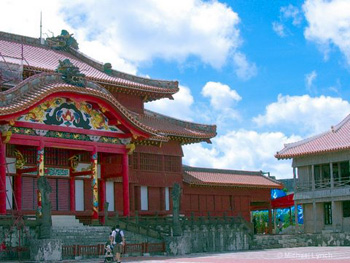
Japan
by Keith T. Graff
Okinawa is the smallest and southernmost of Japan’s 47 prefectures. It’s part of an island archipelago that stretches from southern Kyushu in Japan to within view of Taiwan. The Prefecture makes up roughly one percent of the Japan’s total land mass and similarly, constitutes one percent of the nation’s total population. It was also the scene of the last and greatest land battle in the Pacific theater of WWII. Today it claims nine UNESCO World Heritage sites, five of which are ancient castles.
It was once known as the Kingdom of the Ryukyu’s but, when the first Sho Dynasty faded from prominence, it fragmented into three separate kingdoms. Nanzan was the southernmost and tiniest of the three. Chuzan was the central kingdom, most populated and the richest. These two smaller kingdoms occupied the southern third of the island. Hokuzan was the northernmost, largest in land mass and least populated. It also controlled the Amami island group which is now part of present day Kagoshima Prefecture to the north.
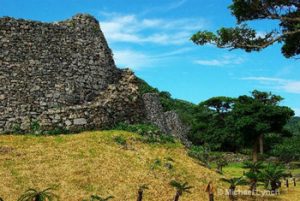 All three kingdoms vied for preeminence. The prize was trade with China. Chuzan was first to gain diplomatic recognition with China and the others soon followed suit. While China did officially recognize the three entities, they made it known that they preferred dealing with just one. It took one man’s vision and another’s allegiance to make that a reality!
All three kingdoms vied for preeminence. The prize was trade with China. Chuzan was first to gain diplomatic recognition with China and the others soon followed suit. While China did officially recognize the three entities, they made it known that they preferred dealing with just one. It took one man’s vision and another’s allegiance to make that a reality!
Sho Hashi was the King of Chuzan and heir of the previous Sho Dynasty. He dreamed of reuniting the kingdom once again under his family’s rule. Though Chuzan was the richest of the three kingdoms, he still needed some extra muscle in order to achieve his dream. Enter Gosamaru, the powerful Lord of Yamada, Hokuzan’s southernmost fiefdom. In Sho Hashi’s mind, he literally held the keys to the kingdom.
Sho Hashi persuaded Gosamaru to ally with him and together they marched on Nakijin Castle in the distant Motobu Peninsula. Nakijin castle is the first of our UNESCO World Heritage castles and a formidable obstacle. Through a little bit of trickery, they convinced the King of Hokuzan that his army had their armies on the run and the only thing needed for total victory was a final cavalry charge. Once the king of Hokuzan committed his cavalry, the undefended castle walls were breached and Nakijin fell.
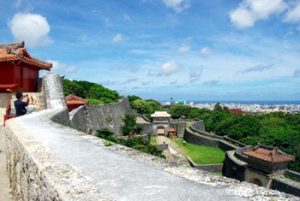 Today, Nakijin Castle is the main tourist attraction in Nakijin Village. It’s a rural district of farms and quaint fishing enclaves. Life here moves at its own relaxed pace. The castle ruins sit high on a ridge that provided the occupants a commanding view of the East China Sea. From its craggy ramparts, one could monitor the whole northwestern third of the island.
Today, Nakijin Castle is the main tourist attraction in Nakijin Village. It’s a rural district of farms and quaint fishing enclaves. Life here moves at its own relaxed pace. The castle ruins sit high on a ridge that provided the occupants a commanding view of the East China Sea. From its craggy ramparts, one could monitor the whole northwestern third of the island.
Once Hokuzan was back in the fold, King Sho Hashi set his eyes southward. To show the Lords of Nanzan that they were next on the menu, he began constructing a new castle at Shuri on the very border of the Nanzan Kingdom. Built high upon the ridge it is within view of Ozato castle, then the seat of the southern kingdom. Though devastated during WWII, today Shuri castle has been restored to the height of its glory. As the seat of the reunited Ryukyu Kingdom it became the grandest of all the castles in Okinawa. It is the second of our UNESCO World Heritage sites and the pride of Okinawa.
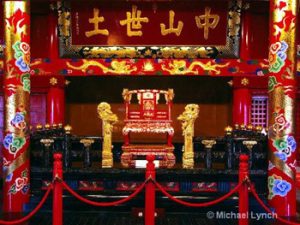 Today Shuri Castle is the most visited tourist attraction in all of Okinawa. Here visitor’s marvel at architecture, evidence of Ryukyu’s strong ties to medieval China. In many ways, it resembles Peking’s Forbidden City in miniature. Of all our castle sites, this one has been improved to the point of being almost totally barrier free. Employees dressed in period costumes act as guides and many are more than happy to pose for pictures for or with anyone who asks. The castle also served as an important venue for the 2000 G8 summit hosted by Japan.
Today Shuri Castle is the most visited tourist attraction in all of Okinawa. Here visitor’s marvel at architecture, evidence of Ryukyu’s strong ties to medieval China. In many ways, it resembles Peking’s Forbidden City in miniature. Of all our castle sites, this one has been improved to the point of being almost totally barrier free. Employees dressed in period costumes act as guides and many are more than happy to pose for pictures for or with anyone who asks. The castle also served as an important venue for the 2000 G8 summit hosted by Japan.
After the Ryukyu Kingdom was reunited by the Sho family, Gosamaru was appointed to the post of Loyal Retainer and his power within the kingdom was second only to the king. The friendship between the two was further cemented by the marriage of the king’s son and heir, Sho Taikyu, to Gosamaru’s daughter. Gosamaru was also appointed the Governor of Hokuzan and it is said that he served the King loyally.

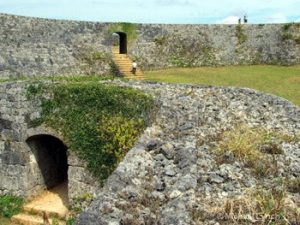 Zakimi Castle, our third UNESCO World Heritage Castle, differs from the other castles in this tale in three ways. Previously, castles on Okinawa were made from rough stone that was carefully stacked one atop another. At Zakimi, for the first time on Okinawa they used stones cut to precision and fit to each other. This technique was used in later castle renovations throughout the island to include Shuri. Secondly, where other castles were built high atop easily defended mountain ridges, Zakimi is built upon a lower lying earthen hilltop that was more suitable for agriculture than defense. Lastly, Zakimi castle was first and foremost a private estate rather than a military outpost.
Zakimi Castle, our third UNESCO World Heritage Castle, differs from the other castles in this tale in three ways. Previously, castles on Okinawa were made from rough stone that was carefully stacked one atop another. At Zakimi, for the first time on Okinawa they used stones cut to precision and fit to each other. This technique was used in later castle renovations throughout the island to include Shuri. Secondly, where other castles were built high atop easily defended mountain ridges, Zakimi is built upon a lower lying earthen hilltop that was more suitable for agriculture than defense. Lastly, Zakimi castle was first and foremost a private estate rather than a military outpost.
Gosamaru was only able to enjoy retirement in his new home for a few years. When Sho Hashi passed away, his son Sho Taikyu ascended the throne and Gosamaru’s daughter was now the queen. Unfortunately, Amawari, the lord of Katsuren Castle, our fourth UNESCO site, was making mischief by forging his own foreign trade agreements and alliances.
The ruins at Katsuren that stand today are but a third of the whole as it was during the height of its glory. All that remains are the higher portions of the castle’s keep and the area immediately below where the Lord of the manner’s house once stood. The keep at Katsuren differs from other castles on the island in that it offers a full unobstructed 360 degree view of the peninsula on which it sits. From this vantage point, on a clear day, one could literally observe most of the East coast of the island as well as an advancing army from far off in the distance.
In an attempt to assuage Lord Amawari’s lust for power, the new king offered his daughter, Gosamaru’s granddaughter, to him in a marriage alliance. Then for added insurance, he ordered Gosamaru to move to his residence from his retirement estate at Zakimi to the ancient fortress castle at Nakagusuku, our fifth UNESCO World Heritage site, which stands between Katsuren and Shuri.
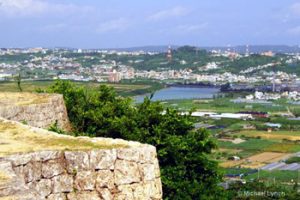 Nakagusuku castle is one of the oldest on the island. Originally, it was built in the same manner as Nakijin Castle with rough stones stacked one atop another. It was improved dramatically during Gosamaru’s short stay with fine cut stones reinforcing the outer and inner walls. Situated on a ridge high above the Pacific Ocean, it is within view of the castle at Katsuren. To the north end of the castle is a large open area that resembles a modern parade field where it’s quite likely that Gosamaru trained troops to defend against Amawari.
Nakagusuku castle is one of the oldest on the island. Originally, it was built in the same manner as Nakijin Castle with rough stones stacked one atop another. It was improved dramatically during Gosamaru’s short stay with fine cut stones reinforcing the outer and inner walls. Situated on a ridge high above the Pacific Ocean, it is within view of the castle at Katsuren. To the north end of the castle is a large open area that resembles a modern parade field where it’s quite likely that Gosamaru trained troops to defend against Amawari.
But history tells us that Amawari was known for being a sly one and used his new position as son-in-law to gain an audience with the king. He persuaded the King that it was Gosamaru rather than he who was the real threat. He knew very well that Gosamaru was raising and training an army but he convinced the king to send scouts to confirm his half truths. When the scouts returned and reported that Gosamaru was indeed training troops for war, the inexperienced king hastily ordered Amawari to take the king’s army, and bring Gosamaru to Shuri.
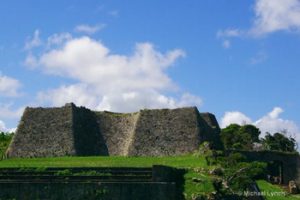 But, instead of simply arresting Gosamaru as the King had ordered, Amawari used the king’s army to lay all-out siege to Nakagusuku castle. Gosamaru seeing that it was the King’s army that had come to make war against him chose suicide rather than fight against his King. By committing suicide rather than fight, he demonstrated his loyalty to the bitter end!
But, instead of simply arresting Gosamaru as the King had ordered, Amawari used the king’s army to lay all-out siege to Nakagusuku castle. Gosamaru seeing that it was the King’s army that had come to make war against him chose suicide rather than fight against his King. By committing suicide rather than fight, he demonstrated his loyalty to the bitter end!
As clever as he was, Amawari had not anticipated this turn of events. He knew very well that now the king would see through his lies. So instead of facing the music, he fled back to the safety of Katsuren. The king sent his armies to march on Amawari’s fortress. The walls at Katsuren Castle, believed to be impregnable, were breached in just two days.
One might call it a form of poetic justice that the story goes that Amawari was thrown to his death off the very castle keep where it is said that he had murdered his former Lord and master years before. Peace and stability returned once again to the tiny Ryukyu Kingdom but at a terrible cost.
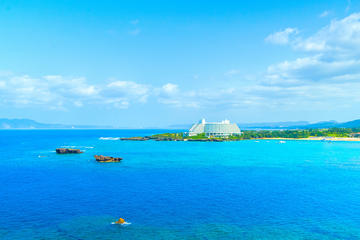
Private Okinawa Custom One-Day Tour by Chartered Vehicle
If You Go:
Today all of the castles featured in this story are a tangible link to the glory days of the Ryukyu Kingdom and a source of great pride. They are popular tourist attractions and the host to various festivals throughout the calendar year. Tourists can access the Castle at Shuri, situated on the outskirts of Naha by bus or monorail but to see the rest, a rental car is the preferred mode of travel. More information on each of the sites is available on the Official Okinawa Travel Guide website.
About the author:
Keith T. Graff is a U.S. Navy retiree living and loving life as an expatriate in the “Goya Republic” aka Okinawa Japan. In addition to teaching business and management courses at a local college, he does freelance writing and photography for regional English language publications. Self described as a writer first, photographer second and a hack wannabe at both, his genre is travel writing and the photo essay.You can find more of his work online at his website: www.goyarepublic.com and his blog: goyrepublicezine.blogspot.com
Photo credits:
All photos are by Michael Lynch, a Photographer/Writer in Okinawa, Japan. His web site: www.mikesryukyugallery.com.


Leave a Reply
You must be logged in to post a comment.